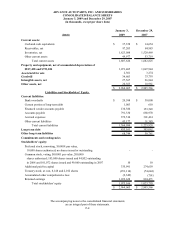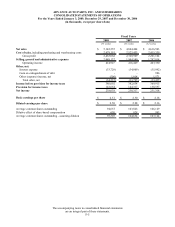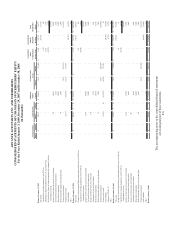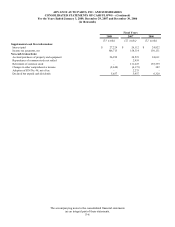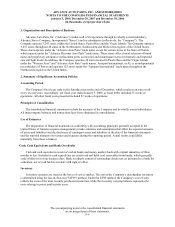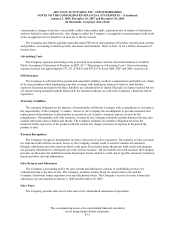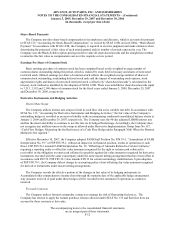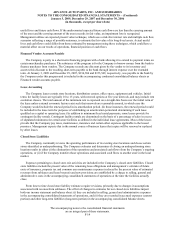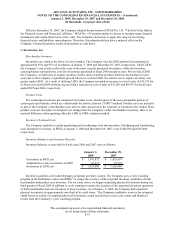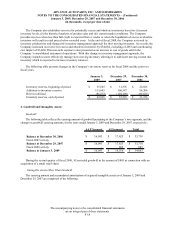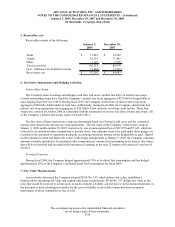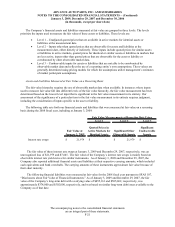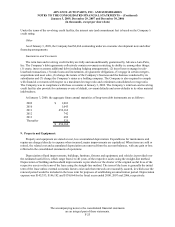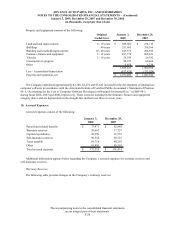Advance Auto Parts 2008 Annual Report Download - page 68
Download and view the complete annual report
Please find page 68 of the 2008 Advance Auto Parts annual report below. You can navigate through the pages in the report by either clicking on the pages listed below, or by using the keyword search tool below to find specific information within the annual report.ADVANCE AUTO PARTS, INC. AND SUBSIDIARIES
NOTES TO THE CONSOLIDATED FINANCIAL STATEMENTS – (Continued)
January 3, 2009, December 29, 2007 and December 30, 2006
(in thousands, except per share data)
The accompanying notes to the consolidated financial statements
are an integral part of these statements.
F-14
useful lives and future cash flows. If the undiscounted expected future cash flows are less than the carrying amount
of the asset and the carrying amount of the asset exceeds its fair value, an impairment loss is recognized.
Management utilizes an expected present value technique, which uses a risk-free interest rate and multiple cash flow
scenarios reflecting a range of possible outcomes, to estimate the fair value of its long-lived assets. Actual useful
lives and cash flows could differ from those estimated by management using these techniques, which could have a
material affect on our results of operations, financial position or cash flows.
Financed Vendor Accounts Payable
The Company is party to a short-term financing program with a bank allowing it to extend its payment terms on
certain merchandise purchases. The substance of the program is for the Company to borrow money from the bank to
finance purchases from vendors. The Company records any discount given by the vendor to its inventory and
accretes this discount to the resulting short-term payable to the bank through interest expense over the extended
term. At January 3, 2009 and December 29, 2007, $136,386 and $153,549, respectively, was payable to the bank by
the Company under this program and is included in the accompanying condensed consolidated balance sheets as
Financed vendor accounts payable.
Lease Accounting
The Company leases certain store locations, distribution centers, office space, equipment and vehicles. Initial
terms for facility leases are typically 10 to 15 years, with renewal options at five year intervals, and may include rent
escalation clauses. The total amount of the minimum rent is expensed on a straight-line basis over the initial term of
the lease unless external economic factors exist such that renewals are reasonably assured, in which case the
Company would include the renewal period in its amortization period. (In those instances, the renewal period would
be included in the lease term for purposes of establishing an amortization period and determining if such lease
qualified as a capital or operating lease.) In addition to minimum fixed rental payments, some leases provide for
contingent facility rentals. Contingent facility rentals are determined on the basis of a percentage of sales in excess
of stipulated minimums for certain store facilities as defined in the individual lease agreements. Most of the leases
provide that the Company pay taxes, maintenance, insurance and certain other expenses applicable to the leased
premises. Management expects that in the normal course of business leases that expire will be renewed or replaced
by other leases.
Closed Store Liabilities
The Company continually reviews the operating performance of its existing store locations and closes certain
stores identified as underperforming. The Company evaluates and determines if closing an underperforming store
location results in either (i) the elimination of the operations and associated cash flows from the Company’s ongoing
operations, or (ii) if the Company transfers those operations and associated cash flows to another store in the local
market.
Expenses pertaining to closed store exit activities are included in the Company’s closed store liabilities. Closed
store liabilities include the present value of the remaining lease obligations and management’s estimate of future
costs of insurance, property tax and common area maintenance expenses (reduced by the present value of estimated
revenues from subleases and lease buyouts) and new provisions are established by a charge to selling, general and
administrative costs in the accompanying consolidated statements of operations at the time the facilities actually
close.
From time to time closed store liability estimates require revisions, primarily due to changes in assumptions
associated with revenue from subleases. The effect of changes in estimates for our closed store liabilities impact
both our income statement and balance sheet: (i) they are included in selling, general and administrative expenses
in the accompanying consolidated statements of operations, and (ii) they are recorded in accrued expenses (current
portion) and other long-term liabilities (long-term portion) in the accompanying consolidated balance sheets.


